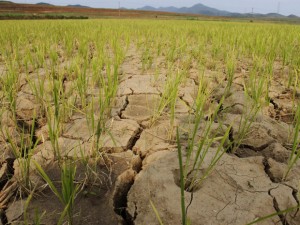 Stating that the country has experienced two successive years of poor rains, Union Agriculture & Farmers Welfare Minister, Shri Radha Mohan Singh has said that immediately after the IMD’s monsoon forecasts in April, 2015 recognizing the gravity of the situation, Government of India, in collaboration with State Governments, responded rapidly with a multi-pronged approach to mitigate the effects of the drought. The Minister has outlines various measures taken by the Government here today. These include among others,
Stating that the country has experienced two successive years of poor rains, Union Agriculture & Farmers Welfare Minister, Shri Radha Mohan Singh has said that immediately after the IMD’s monsoon forecasts in April, 2015 recognizing the gravity of the situation, Government of India, in collaboration with State Governments, responded rapidly with a multi-pronged approach to mitigate the effects of the drought. The Minister has outlines various measures taken by the Government here today. These include among others,
The Central Research Institute for Dryland Agriculture (CRIDA), in collaboration with the State Agricultural Universities, prepared a Contingency Plan for 600 Districts to implement location specific interventions to sustain agriculture production. Weekly video conferences with State Governments to discuss rainfall patterns, supply of seeds, the impact of drought and other related issues were held. Weekly meetings of the Crop Weather Watch Group were also held. Adequate quantities of drought resistant seeds and seeds of low water intensive crops were made available.
The States took various measures like in-situ soil and moisture conservation, micro-irrigation and ground water re-charge. These steps ensured that in spite of two successive droughts, the overall agriculture production has not dipped and food stocks are adequate.
Drinking Water
There are 1.71 million rural habitations in the country. More than 25% of these habitations (441,390) are facing drinking water scarcity.
To address the situation the Governments have taken the following measures:
- Repair/restoration of 738,650 hand pumps;
- Addition of 1,076,961 meters of riser pipe to boreholes in order to access deeper groundwater reserves;
- Establishment of 1,398 temporary piped water supply schemes;
- Water trucking through tankers to 15,345 habitations ;
- Hiring of 13,372 private bore wells to augment water supply; and
- Commissioning of 44,498 new bore wells
The government has released Rs. 819.67 Crore under ARDWP to the States as the first installment for 2016/17. Further, the States have also been requested to utilise the Flexi Fund under the programme to mitigate scarcity of drinking water in drought affected districts. The Government is closely monitoring the situation on a daily basis.
Food: The National Food Security Act (NFSA) is already implemented in all the drought affected States. Continuous persuasion with the States resulted in the number of States/UTs under NFSA increasing from 11 to 33 in the past year. At present all beneficiaries in drought affected States – are receiving food grains under NFSA at NFSA prescribed rates. Additional allocation of food grains has been made to Maharashtra and Karnataka States on their request.
The Mid Day Meal Scheme provides for serving of mid-day meals to eligible school children during summer vacations in areas declared to be drought affected by the State Government. The majority of the drought affected states have obtained financial approvals to serve mid-day meals during summer vacations in their drought affected districts/areas.
Assistance to distressed Farmers: The Government enhanced the quantum of input subsidy (relief assistance to farmers) provided under SDRF/NDRF by 50% in April 2015. Further, the norms for assistance were also made more farmer-friendly by setting the threshold for assistance at a crop loss of 33% or above rather than the earlier threshold of 50%. Under NDRF, Rs. 10,275 Crore has been released to States, the highest assistance ever provided.
The Reserve Bank of India amended the criteria of crop loss from 50% to 33% in the guidelines for relief measures by Banks in areas affected by natural calamities All the State Governments were advised to take necessary steps, in coordination with Banks and District Level Coordination Committees (DLCC) to implement the amended guidelines so that relief is extended to farmers. Loans worth more than Rs. 15000 crore have already been restructured.
Insurance companies were proactively persuaded to make timely payment of insurance claims. Claims to the excess of Rs.13,000 crore have either been paid or are being settled expeditiously. This is more than double the amount paid out last year. States have also been requested to send the claims for the Rabi season urgently.
The Government of India has rolled out a new Crop Insurance Scheme called the Pradhan Mantri Fasal Bima Yojna from Kharif 2016. The scheme has the lowest ever premium for the Farmer-1.5% for Rabi and 2% for Kharif. It has also enabled insurance cover to be provided for various risks that have hitherto been uninsurable. The scheme aims to increase the insurance coverage from 23% to 50% of the cropped area.
Employment: The Mahatma Gandhi National Rural Employment Guarantee has been strengthened as a concerted response to tackle agrarian distress and to meet the demand for work in drought affected areas, creating durable, income generating assets in the process. In the year 2015-16, States were asked to provide employment where needed, particularly in drought affected areas, with the assurance that the Government of India would make the required resources available.
In response to this, 13 States generated person days beyond their estimated labour budgets for the Financial Year 2015-2016. The financial commitments made to these states have been honoured. The programme achieved the following mile-stones:
235 Crore person days have been generated in the last FY (49 days per household), which is highest in the last five years; The expenditure of Rs. 42,253.75 Crore in FY 2015-16 is the highest ever since the inception of the programme.
More than 63% of the total expenditure was on agriculture and related works with a focus on Natural Resource Management (NRM) and water conservation.
The entitlement has been expanded from 100 to 150 days of work to households in drought affected regions. More than 20 Lakh households in these regions have availed this opportunity and exceeded 100 days of work.
In 2015-16, Rs. 33,000 Crore was initially allocated under MNREGA. This year, the initial allocation is Rs.38,500 Crore, and this will be further augmented based on demand from the States. On the 7th of April 2016, the Ministry directed all States to maintain the tempo of work from April to June, especially in drought affected regions. The Government is fully committed to ensure that the necessary resources are made available to meet the demand for work.
Livelihoods: Livelihood diversification is an essential part of the drought response strategy. Every block in the drought affected areas is being targeted for intensive work under the Deen Dayal Antyodaya Mission. This involves risk mitigation through the development of multiple livelihoods and by formation and support of self-help groups.
At least eighteen lakh young people from households who have completed 100 days of employment in any of the last two years will undergo skills training through Project LIFE (Livelihoods in full Employment).
Water Security and Drought Proofing: Under the Integrated Watershed Management Programme (IWMP), a series of activities have been undertaken to develop rainfed/degraded areas and wastelands. An amount of Rs. 1,064.23 Crore was released to drought affected States during 2015-16 for watershed related activities.
The Government has also undertaken pre-monsoon preparedness by advising the affected States on a series of short and medium term measures to conserve water received during the monsoon period and to better manage the demand for existing water resources.
In addition to these national actions, States have created district level plans which address local issues of availability of drinking water and fodder as well as the establishment of cattle camps and provision of food for those in need. For example, the State of Maharashtra has launched the Jalyukt Shivar Abhiyan in which village level plans have been prepared to renovate and rejuvenate water bodies to improve water security.
